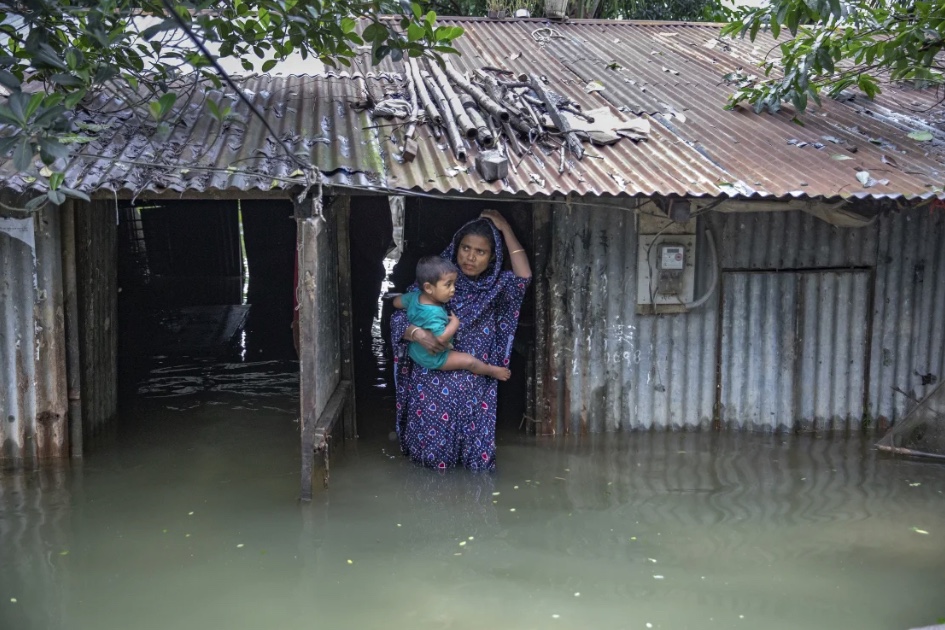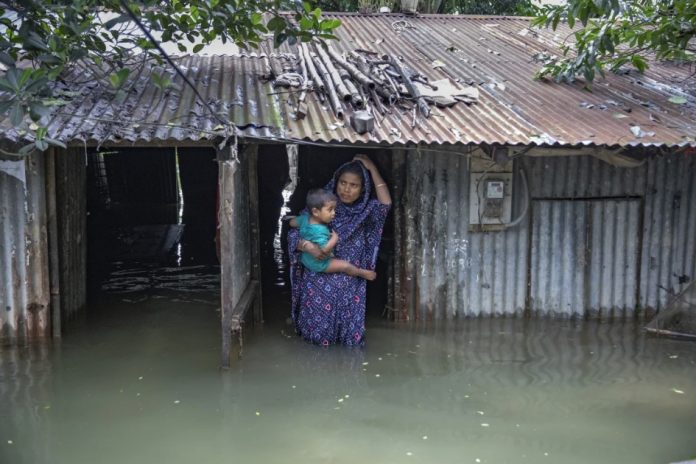สื่อของรัฐและหน่วยงานด้านมนุษยธรรมรายงานว่า ประชาชนเกือบ 1.8 ล้านคนในภาคตะวันออกเฉียงเหนือของบังกลาเทศติดอยู่หลังจากฝนตกหนักหลายสัปดาห์ทำให้เกิดน้ำท่วมครั้งใหญ่ บ้านเรือนจมอยู่ใต้น้ำ และพื้นที่เพาะปลูกที่สร้างความเสียหาย พื้นที่ขนาดใหญ่ของเมืองซิลเหต (Sylhet) และสุนัมคัญจ์ (Sunamganj) จมอยู่ใต้น้ำในช่วงน้ำท่วมระลอกที่ 2 ในเวลาไม่ถึงหนึ่งเดือน ตามรายงานของสำนักข่าว BSS ของรัฐ คณะกรรมการพัฒนาน้ำระบุด้วยว่ามีฝนตกหนักและน้ำไหลบ่าอย่างต่อเนื่องจากพื้นที่เนินเขาทางตอนเหนือของชายแดนอินเดีย ทำให้แม่น้ำ 4 สายเอ่อล้นเกินระดับอันตราย ชาวบ้านในพื้นที่ราบต่ำของ ซิลเหต กำลังลุยน้ำลึกถึงทรวงอก กองข้าวของเพื่อป้องกันน้ำท่วม สื่อท้องถิ่นรายงานว่า ความกังวลเพิ่มขึ้นสำหรับผู้ที่ติดอยู่ในน้ำท่วม โดยเผชิญกับการขาดแคลนอาหารและการขาดน้ำสะอาด ผู้คนราว 964,000 คนในซิลเฮต และ 792,000 คนในสุนัมคัญจ์ได้รับผลกระทบ โดยมีการจัดตั้งที่พักพิงมากกว่า 6,000 แห่งเพื่อรองรับผู้พลัดถิ่น BSS รายงาน ยูนิเซฟกล่าวว่าเด็ก 772,000 คนต้องการความช่วยเหลือเร่งด่วน น้ำท่วมโรงเรียนกว่า 800 แห่ง และอีก 500 แห่งใช้เป็นที่พักพิง
องค์กรพัฒนาระหว่างประเทศ BRAC กำลังจัดส่งอาหารและความช่วยเหลือด้านสุขภาพฉุกเฉินให้กับหลายร้อยครอบครัวใน ซิลเหต และ สุนัมคัญจ์ ซึ่งน้ำท่วมฉับพลันส่งผลกระทบต่อประชาชน 2.25 ล้านคน และทำให้ 12,000 คนไม่มีไฟฟ้าใช้ Kondoker Golam Tawhid หัวหน้าโครงการจัดการความเสี่ยงจากภัยพิบัติของ BRAC เตือนว่าน้ำท่วมในบังกลาเทศกำลังเป็นอันตรายมากขึ้นเรื่อยๆ ทำให้เกิดความสูญเสียครั้งใหญ่ต่อการดำรงชีวิต ความหลากหลายทางชีวภาพ โครงสร้างพื้นฐาน การศึกษา และบริการด้านสุขภาพ เกษตรกรผู้เลี้ยงปลาต้องสูญเสียเงินกว่า 11.4 ล้านเหรียญสหรัฐ เนื่องจากน้ำท่วมพัดพาฟาร์มและบ่อน้ำไป บังกลาเทศซึ่งมีแนวโน้มที่จะมีฝนตกตามฤดูกาล น้ำท่วม และพายุไซโคลน มีความเสี่ยงสูงต่อวิกฤตสภาพภูมิอากาศ การศึกษาแสดงให้เห็นว่าประเทศเผชิญกับผลกระทบด้านมนุษยธรรมและเศรษฐกิจที่เลวร้ายลงเมื่อเหตุการณ์สภาพอากาศสุดขั้วเพิ่มมากขึ้น ธนาคารโลกคาดการณ์ว่าจะมีผู้อพยพตามสภาพภูมิอากาศ 13 ล้านคน และ GDP จะลดลงสูงสุดถึง 9% ภายในปี 2593 เนื่องจากน้ำท่วมรุนแรง น้ำท่วมครั้งล่าสุดเกิดขึ้นในขณะที่ภูมิภาคกำลังฟื้นตัวจากพายุหมุนเขตร้อนรีมัลในช่วงปลายเดือนพฤษภาคม ซึ่งส่งผลกระทบต่อผู้คนประมาณ 5 ล้านคน
ฝนมรสุมและดินถล่มส่งผลกระทบต่อบังกลาเทศตอนใต้ ส่งผลกระทบต่อผู้ลี้ภัยชาวโรฮิงญาเกือบล้านคนในค่ายต่างๆ หลังจากหนีออกจากเมียนมาร์ มีผู้เสียชีวิตอย่างน้อย 10 คน รวมถึงเด็ก 3 คน เสียชีวิตจากโคลนถล่มและฝนตกหนักใกล้กับคอกซ์บาซาร์ ตามการระบุของกระทรวงการจัดการและบรรเทาภัยพิบัติของบังกลาเทศ เซฟเดอะชิลเดรนรายงานว่ามีผู้คนมากกว่า 8,000 คนในค่าย 33 แห่งที่ได้รับผลกระทบจากฝนตกหนัก ซึ่งทำลายหรือสร้างความเสียหายให้กับที่พักพิงมากกว่า 1,000 แห่ง ฤดูมรสุมเพิ่งเริ่มต้นและอาจส่งผลให้สภาพอากาศเลวร้ายยิ่งขึ้นไปอีกในช่วงสองเดือนข้างหน้า ในรัฐอัสสัม ประเทศอินเดีย น้ำท่วมและดินถล่มส่งผลกระทบต่อประชาชนมากกว่า 4 ล้านคน ส่งผลให้มีผู้เสียชีวิตอย่างน้อย 31 รายนับตั้งแต่วันที่ 29 พฤษภาคม
Nearly 2 million people are stranded as second wave of devastating floods hits Bangladesh in less than a month.

Nearly 1.8 million people in northeast Bangladesh are stranded after weeks of heavy rain caused extensive flooding, submerging homes and devastating farmland, state media and humanitarian agencies report. Large areas of Sylhet city and Sunamganj are underwater in the second wave of flooding in less than a month, according to the state-run news agency BSS. Prolonged torrential rain and runoff from hilly regions upstream on the India border swelled four rivers beyond their danger levels, the Water Development Board stated. Villagers in low-lying areas of Sylhet are wading through chest-deep water, piling belongings to protect them from flooding. Concerns are rising for those trapped by floodwaters, facing food shortages and lack of clean water, local media report. Around 964,000 people in Sylhet and 792,000 in Sunamganj are affected, with over 6,000 shelters set up for the displaced, BSS reported. UNICEF said 772,000 children need urgent assistance. Over 800 schools are flooded, with 500 more used as shelters.
BRAC, an International development organisation, is delivering emergency food and health support to hundreds of families in Sylhet and Sunamganj, where flash floods have affected 2.25 million people and left 12,000 without power. Khondoker Golam Tawhid, head of BRAC’s Disaster Risk Management Program, warned that flooding in Bangladesh is becoming increasingly dangerous, causing major losses to livelihoods, biodiversity, infrastructure, education, and health services. Fish farmers have suffered over $11.4 million in losses as floodwaters washed away farms and ponds. Bangladesh, prone to seasonal rains, flooding, and cyclones, is highly vulnerable to the climate crisis. Studies show the country faces worsening humanitarian and economic impacts as extreme weather events increase. The World Bank predicts 13 million climate migrants and a GDP drop of up to 9% by 2050 due to severe flooding. Recent floods hit as the region was recovering from late May’s Tropical Cyclone Remal, which affected about 5 million people.
Monsoon rains and landslides have impacted southern Bangladesh, affecting nearly a million Rohingya refugees in camps after fleeing Myanmar. At least 10 people, including three children, died from mudslides and heavy rainfall near Cox’s Bazar, according to Bangladesh’s Ministry of Disaster Management and Relief. Save the Children reported over 8,000 people in 33 camps affected by torrential downpours, which destroyed or damaged more than 1,000 shelters. The monsoon season has just begun and may bring more severe weather for the next two months. In neighbouring Assam, India, floods and landslides have affected over 4 million people, resulting in at least 31 deaths since May 29.
By CNN NEWS

















